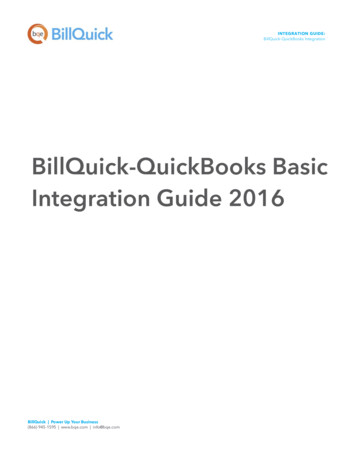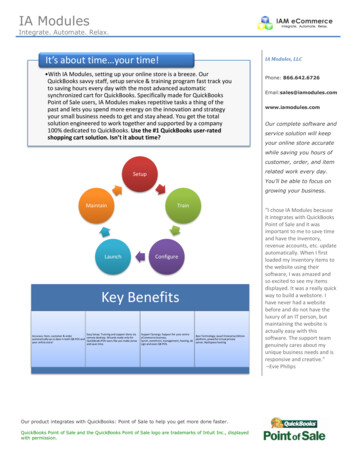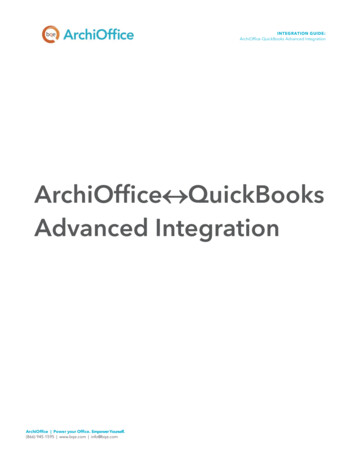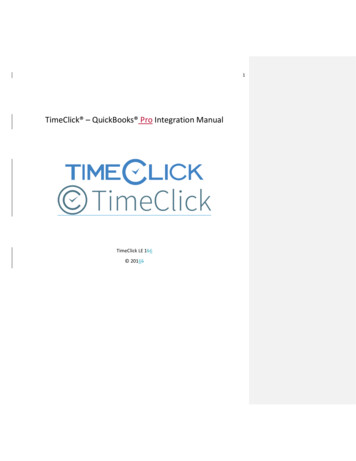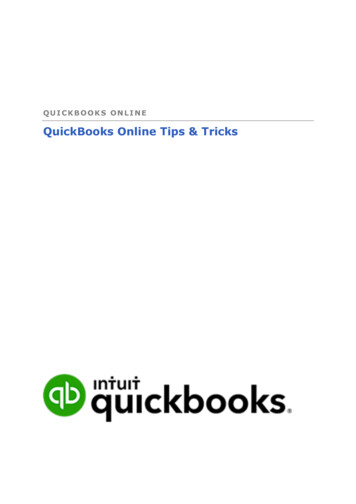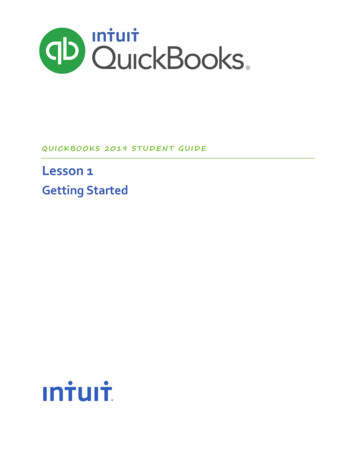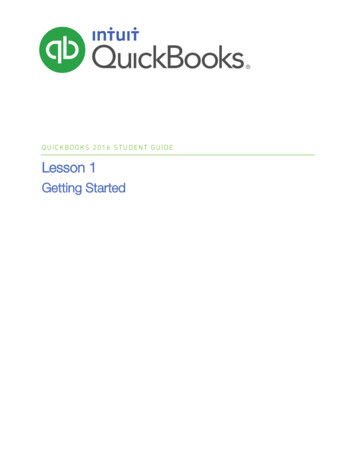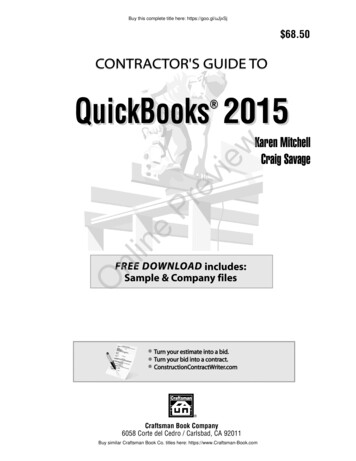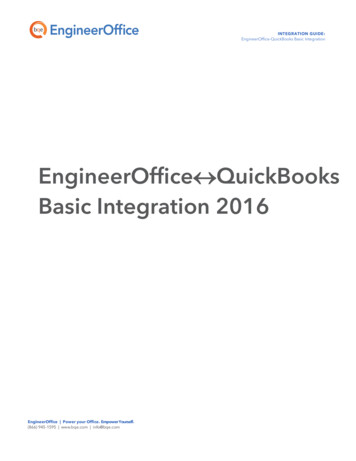
Transcription
INTEGRATION GUIDE:EngineerOffice-QuickBooks Basic IntegrationEngineerOffice QuickBooksBasic Integration 2016EngineerOffice Power your Office. Empower Yourself.(866) 945-1595 www.bqe.com info@bqe.com
INTEGRATION GUIDE:EngineerOffice-QuickBooks Basic IntegrationCONTENTSINTRODUCTION . 1SOFTWARE EDITIONS SUPPORTED. 1HOW INTEGRATION WORKS . 2INTEGRATION RULES . 3INTEGRATION SETTINGS . 3DATA INTEGRATION . 4INITIAL INTEGRATION. 5DATA VERIFICATION . 7DAY-TO-DAY INTEGRATION SETTINGS . 8BEST PRACTICES . 9EngineerOffice Power your Office. Empower Yourself.(866) 945-1595 www.bqe.com info@bqe.com
INTEGRATION GUIDE:EngineerOffice-QuickBooks Basic IntegrationINTRODUCTIONData integration between EngineerOffice (by BQE Software) and QuickBooks (by Intuit) can make yourtime billing, accounting, and financial management tasks easier. The full-featured EngineerOffice helps youmanage your company, whether your time, expense, billing and reporting needs are simple or you requirecomplex billing, reporting and management capabilities. With EngineerOffice, you are equipped with apowerful office and project management solution for engineers. QuickBooks is a business accountingsoftware that provides solutions such as general accounting, accounts receivable, accounts payable, onlinebanking, reporting, payroll, and other functions. Integrated, EngineerOffice and QuickBooks deliver a virtualprogram that ensures data accuracy, eliminates time-consuming duplicate manual entry, enhancesflexibility, and increases control over your bottom line.Integration means data from one program transfers to another. This sharing offers many benefits. Youcontrol what data transfers to and from EngineerOffice using synchronization settings. Your preferences tellEngineerOffice exactly how you want it to interact with QuickBooks. EngineerOffice automatically createssmart connections using your settings and its built-in intelligence.The goal of the EngineerOffice-QuickBooks Basic Integration Guide is to help you effectively integrate databetween EngineerOffice and QuickBooks. EngineerOffice controls integration, enabling you to chooseaccounts, what data flows between the programs, and much more.For detailed integration information, see the EngineerOffice-QuickBooks Advanced Integration Guide.You can contact us at support@EngineerOffice.com to help you with the data integration process.Check out EngineerOffice Training for a standard or custom training course on data integration withQuickBooks. BQE Software also offers Consulting Services in these areas.Software Editions SupportedAll EngineerOffice 2016 editions integrate with the following QuickBooks editions: QuickBooks Pro/Premier/Enterprise Solutions editions, including the Accountant’s Edition (2010and later) QuickBooks Canadian edition (2012 and later) QuickBooks UK edition (2012 and later)QuickBooks Plus edition is not supported.EngineerOffice Power your Office. Empower Yourself.(866) 945-1595 www.bqe.com info@bqe.com1
INTEGRATION GUIDE:EngineerOffice-QuickBooks Basic IntegrationHOW INTEGRATION WORKSIt is helpful to understand the basics of the EngineerOffice QuickBooks integration, whether or not youhave a technical background. This can help you visualize what is happening behind the scenes asEngineerOffice manages the transfer of data to and from QuickBooks.There are some differences between QuickBooks and EngineerOffice that need to be understood in orderto ensure a smooth and accurate data integration. EngineerOffice is project-centric and supports ahierarchical structure while QuickBooks is client-centric and uses a flat project structure. Each recordcommon to EngineerOffice and QuickBooks shares a unique Link ID that identifies them as related. Thisdoes not mean data in both databases is exactly the same, only that they share common data.EngineerOffice Project records contain data and options that QuickBooks Job records do not and viceversa. What is important for integration are that the two programs share key data.Back up your data in QuickBooks and EngineerOffice prior to data synchronization.The table below shows the direction data can potentially flow between EngineerOffice and QuickBooks.Whether it flows in one direction or the other (or both directions) depends on choices made on theEngineerOffice-QuickBooks Integration Settings screen. You can determine how data flows to and fromEngineerOffice and also which General Ledger accounts in QuickBooks are posted.EngineerOffice Table NameDataflowQuickBooks Table NameJob Codes Service ItemsAccount Codes Other Charge ItemsContacts (Employees) * EmployeesContacts (Vendors)* VendorsContacts (Clients)* CustomersProjects JobsTime/Expense Time/Expense Bills and ChecksInvoices Invoices(Time Card)(Expenses)EngineerOffice Power your Office. Empower Yourself.(866) 945-1595 www.bqe.com info@bqe.comTime Tracking(Time Records)2
INTEGRATION GUIDE:EngineerOffice-QuickBooks Basic IntegrationTransactions (Payments) Payments*When the Billing option is checked, all Contacts transfer as Customers.Also see the EngineerOffice Help for EngineerOffice QuickBooks Integration.As you can see above, integration between EngineerOffice and QuickBooks is very comprehensive. Notonly are invoices sent to QuickBooks to post revenue and receivables, the virtual database for the twoprograms includes clients, projects, employees, vendors, job codes, etc.After initial integration, you can set integration rules so that master information transfers only fromEngineerOffice to your accounting package. You would choose ‘Do not Get Data’ (i.e., turn off the flow ofdata) in the Get Settings. In other words, you decide to maintain master data in EngineerOffice only. It flowsto your accounting package, updating its database and keeping information synchronized. You can be justas specific when assigning General Ledger accounts to service, expense and invoice items.Bottom Line: The major benefit is that you do not have to re-enter EngineerOffice data into QuickBooks.EngineerOffice manages the process, using your synchronization settings.Integration RulesEngineerOffice handles most of the time and billing data differently from QuickBooks. To ensure accuracyand completeness of data transfer, EngineerOffice QuickBooks integration follows a set of rules. Some ofthese rules might not be relevant for the first-time data transfer but shall apply in future synchronization.Check out the EngineerOffice-QuickBooks Advanced Integration Guide for details.Integration SettingsIn EngineerOffice, you can specify data transfer rules and settings in the EngineerOffice-QuickBooksIntegration Settings screen. You can also restrict the data sent from or transferred to EngineerOffice bysetting filters. These settings apply company-wide and are used as defaults when you choose to synchronizedata between EngineerOffice and QuickBooks.A key step in the integration process is to assign general ledger (G/L) accounts to EngineerOffice job codesand other invoice items prior to the synchronization. This is because QuickBooks requires G/L accounts forall items and transactions. This is done from the EngineerOffice-QuickBooks Integration Settings screen.EngineerOffice also allows you to assign QuickBooks payroll items and accounts to its payroll items such asregular time, overtime, vacation, and so on for each employee.QuickBooks accounts are available for assignment in EngineerOffice after a connection has beenEngineerOffice Power your Office. Empower Yourself.(866) 945-1595 www.bqe.com info@bqe.com3
INTEGRATION GUIDE:EngineerOffice-QuickBooks Basic Integrationestablished between the two programs.With the EngineerOffice-QuickBooks Integration Settings screen, you can specify the following: Send SettingsGet SettingsAccount AssignmentsPayroll SettingsDATA INTEGRATIONThe initial integration populates the EngineerOffice or QuickBooks company database with informationfrom the other program. Your initial synchronization settings determine what information and how much ofit is shared between the programs. For example, you can decide to move QuickBooks data for only the lasttwo years to EngineerOffice.EngineerOffice Power your Office. Empower Yourself.(866) 945-1595 www.bqe.com info@bqe.com4
INTEGRATION GUIDE:EngineerOffice-QuickBooks Basic IntegrationBoth EngineerOffice and QuickBooks must be running during the integration process. You will first specifythe synchronization options on the EngineerOffice-QuickBooks Integration Settings screen for the initialintegration set up and then use the Get or Send menu to transfer each data type (e.g., Employee, vendor,etc.). You can do this by referring to one of the scenarios covered in this section that best fits your needs.If you are new to EngineerOffice as well as QuickBooks, initial integration tasks will be completed afteryou have set up your information in both programs.Initial IntegrationQuickBooks users who are new to EngineerOffice should start by transferring information from QuickBooksto a new EngineerOffice database. After creating the EngineerOffice company file and setting preferences,you can initiate synchronization and check the transferred data.You can contact us at support@EngineerOffice.com to help you with the data integration process.Check out EngineerOffice Training for a standard or custom training course on data integration withQuickBooks. BQE Software also offers Consulting Services in these areas.Typically, there are four possible scenarios for first-time integration: New EngineerOffice - Existing QuickBooks User Existing EngineerOffice - Existing QuickBooks User New EngineerOffice - New QuickBooks User Existing EngineerOffice - New QuickBooks UserThe steps involved in the first-time integration are very simple:1.Create a new company file or backup an existing company file in EngineerOffice or QuickBooks.2.Grant access rights to EngineerOffice in your QuickBooks program.3.Specify synchronization settings in the EngineerOffice-QuickBooks Integration Settings screen.Later, fine-tune these settings for day-to-day integration process.oGet Settings or Send Settings for each EngineerOffice module (or skip the synchronizationoQuickBooks account assignment for EngineerOffice items (activities, expenses, invoice lineoPayroll settings for EngineerOffice payroll itemsfor some modules)items)EngineerOffice Power your Office. Empower Yourself.(866) 945-1595 www.bqe.com info@bqe.com5
INTEGRATION GUIDE:EngineerOffice-QuickBooks Basic Integration4.Start data synchronization using EngineerOffice-QuickBooks Sync Options.Below are the EngineerOffice Send and Get menu items and the corresponding QuickBooks screens.EngineerOffice ctsJobsMenu ItemClientsJob CodesAccount CodesTime EntriesScreenCustomersService ItemsOther ChargeTime TrackingExpense EntriesBills and ChecksPaymentsPaymentsInvoicesEngineerOffice Power your Office. Empower Yourself.(866) 945-1595 www.bqe.com info@bqe.comInvoices6
INTEGRATION GUIDE:EngineerOffice-QuickBooks Basic IntegrationData adjustments are needed in EngineerOffice after getting data from QuickBooks because EngineerOfficerequires certain fields which might be optional in QuickBooks. Employees: When you get employees from QuickBooks, make sure to check their user and securitysettings in EngineerOffice. Time Entries: When you get time entries from QuickBooks, make sure to update the bill and costrates in EngineerOffice because QuickBooks doesn’t require them. Alternate Contact: Alt. Contact in QuickBooks corresponds to EngineerOffice Project Leader. IfAlternate Contact is not specified in QuickBooks, EngineerOffice fills a placeholder‘FromQuickBooks’ in the Project Leader field. Change that to the appropriate names. Names: Check the names of records (e.g., contacts or projects) transferred from QuickBooks. Youcan change them, if desired. Data Accuracy: Verify other data using reports in EngineerOffice and QuickBooks.Data VerificationA standard procedure after initial synchronization of data between EngineerOffice and QuickBooks is tocheck the transferred data. This ensures that your information is accurate and complete before you beginnormal processing.EngineerOffice contains multiple processes to ensure accurate and complete data transfer. However, asetting in QuickBooks might have restricted the transfer of some data. Or, you might have inadvertentlychecked filters on the EngineerOffice-QuickBooks Integration Settings screen. Checking data before youbegin normal processing ensures no surprises later.After completing syncing of your data, you c
software that provides solutions such as general accounting, accounts receivable, accounts payable, online banking, reporting, payroll, and other functions. Integrated, EngineerOffice and QuickBooks deliver a virtual program that ensures data accuracy, eliminates time
